Tips on Driving and Parking...
...and other survival tips
Offering tips on driving, parking, and life in general is risky, and even moreso for a foreign land. With that said comes my usual disclaimer: I'm not responsible if for some reason you get a ticket, have an accident, or worse (which of course we hope none of these things happen!). With that said, here's a few things I've learned about driving and moving about in Germany in particular, and Europe in general.
1. About renting a car: rent at a location on-site to the airport, such as Frankfurt-Main. It is not worth the few dollars you would save to rent from an off-site company. On one trip I squandered 1 1/2 hours between trying to work through the terrible signage and construction around the Frankfurt Flughafen, and waiting for the shuttle to take me to the airport. If I had not been traveling stand-by, I would have missed my flight. Thus, do not, I say again, do NOT, rent from an off-site provider. Only do so if time, confusion, and frustration are not a concern for you.
1a. A sub-section to above is regarding other transportation. There are many ways to tour Germany: car, train, bicycle, on foot-- or a combination of all. I have done all of these, and it depends on your personal circumstances as to which you choose. I've even "toured" Germany in the turret of a tank and in a jeep, but don't recommend these methods! If you are short of money but have plenty of time, then travel by bicycle, train, and foot. However, the best way to see the most in the least amount of time is to rent a car. It is worth the money. However, I must confess that one of the best trips I've ever taken was when I toured through southwest Germany and down to Switzerland on my bicyle. It was pure adventure, and it is difficult to replicate such experiences! My photo to the lower right is that of my loaded Motobacane (10-Speed only!) touring cycle near the Lahn River. As can be seen, I was traveling VERY light!
2. When topping off ("volltanken") ensure that the station takes credit cards, unless of course you wish to pay cash. With exchange premiums above the spot rate on currency, it is critical to watch how you use your cash. Using a credit card at a gas station will work on the spot rate, with almost no premium service charge. Moreover, be careful you select the type of fuel you want. For example, if you are driving a diesel powered car (a great idea because they get better gas mileage), be sure you don't select "ultimate" grade at an ARAL station, unless of course that's what you want. It can be very easy to overlook the little things and find yourself paying 10 cents more per liter.
3. Watch your speed, even as of 2008. In 2005, there were cameras virtually everywhere in Germany. However, in 2007 and 2008, I noticed a significant decline in these cameras. In 2008, I traveled small towns and roads extensively and saw NOT ONE camera in a small town to check speed, though I saw many of them in 2005. A series of protests in Germany against such survellience in 2007 and 08 obviously had some impact on this. Nevertheless, keep your speed down! Concurrently, while I've seen the number of cameras decline, I have seen the presence of the police go up (though still not as close to that of the US, which is a heavily policed nation). One local informed me in 2005 that if you are not more than 10 kmph over the speed limit you are ok, but I'm NOT, repeat NOT, recommending that you speed in that fashion. Do so at your own risk. If you do get pulled over, police will fine you on the spot. Don't worry... German police are very professional and there is little corruption. If you get pulled over going 30 kmph over the speed limit, you could lose your right to drive. I'm not sure how that plays out with tourists, but I wouldn't want to find out. Also, if you get snapped by a camera, the plate number will be traced to your rental car company, who will tack the fine to your final bill.
4. Regarding speed, be careful to watch the speed limit signs. In Germany, the country is congested compared to the US. Thus, the speed limit goes up and down constantly. You will find yourself going from 30 kmph to 100 kmph in just a few hundred meters, only to find yourself dynamiting the brakes to go back down to 30 kmph! And don't even dream of keeping your speed purposely lower to avoid this, for invariably you will have an impatient German riding your bumper! The only area I did NOT have this happen was in Eastern Germany, because car ownership there is still relatively low compared to Western Germany and the rest of Western Europe. Also, forget about using cruise control (if your car even has it), as you are constantly going up and down on your speed, except on more open stretches of the Autobahn.
5. Don't drift through stop signs or lights, as there are still cameras at these, especially in the larger cities. Come to full, complete stops. When driving in inner cities realize these are often regulated chaos. Some say that tackling the Autobahn is the peak of driving proficiency. Wrong! They need to drive the narrow, twisting roads of a German city (not town, CITY), and then they can talk! I have negotiated my way through cities like Bonn, Karlsruhe, Heidelberg, Frankfurt, and Munich. I've also gotten seriously disoriented in some of those cities! Watch the signs carefully, since you often don't get a second chance to follow a route without a serious hassle to go back. Roads rarely go more than a few blocks before the name changes. This only adds to the confusion. Besides the signage, you have cars, trucks, busses (with special lanes), trams (yet you can drive on the tracks!) bicycles, mopeds, and pedestrians everywhere. Watch for cross walks... you are supposed to stop when a pedestrian is beginning to cross. I once almost plastered a guy in Trier... all because of this sensory overload.
6. Don't drink and drive... PERIOD. The blood alcohol limit in Germany, and most of Europe to my knowledge, is .03. Read that again: .03! Considering the alcohol content in German beer, one can see that it just takes one beer to hit that amount. So the best solution: don't drink and drive. This also includes wine tasting along places like the Mosel and Rhein. Certain types of German wine can be very strong.
7. Regarding signs, learn them. There are good resources you can get from online. One good site is called Driving in Germany, and I recommend it highly. Brian Purcell has done a magnificent job collecting and sorting the confusion of European driving. I actually downloaded and printed all the pages and put them in a small binder, studying them again while on the flight over. For those of you who perhaps visited Germany, or were stationed there many years ago, be careful. With the coming of the European Union (EU) standardization has caused the changing of some important signs. So don't rely on past knowledge.
8. Forget any nonsense you've ever heard about the "great" signage in Germany, or even in Europe. It is actually quite bad in some areas. Example: while heading south on the A-7 from Schweinfurt, I was looking for the exit to take the A-6 to head toward Nurnberg. All the signs indicated the exit would be for Nurnberg, with the eastern exit for Stuttgart. When I got to the exit area there was the exit for Stuttgart... and an exit for... Amberg? At the speed I was going (very fast!), I had to do a rapid mental check... Amberg... Amberg is... EAST of Nurnberg! That was MY exit.... but why Amberg and not Nurnberg? Good question, and one that I have no answer for. I almost missed that one. Also, watch for the signs for various tourist items. Example: the sign to the Marksburg. I'm weaving my way through narrow streets. One sign is white... and then another sign is brown... and mounted high on the corner of a building! You must move your head around a lot to figure out where you're going. And don't worry... there's always... ALWAYS... an impatient local riding your bumper wondering why the stupid moron ahead of him can't figure out where he's going ("Ach... auslander," er gesagt).
9. Then there is the nature of the roads. Many roads in Germany are quite good, and my experience is that they are generally better than those in Eastern France. But in the last few years the Germans have been tearing their roads up, and not all of it because of aging infrastructure. Some of it is simply to provide employment. As a consequence, expect to run into construction anywhere you go, and calculate this into your travel plans. Moreover, some roads, especially in what can be called more remote mountain areas, can be quite bad. Occassionally one will see the sign "Strassen Schaden" pop up, and it's wise to heed this warning. On one road in the Black Forest I snapped a photo (above right), having no idea how BAD the road would be. As I rounded the bend the road began to throw my little Hyundai around like a bottle in an angry sea. I was sure it would toss me off the road and down a 300 foot embankment that had no barriers by this point. I nervously clutched the wheel and struggled to keep my sanity at the same time, wondering how long I had to live. It just served as a good lesson that one must not take things for granted. In one instance, a detour (German: umleitung) took us off the B31 and along curving mountain roads, a 32 km re-route that made me scream in frustration. It must have been just as bad for the truckers who drove their vehicle off the road! (photo, upper right).
10. Parking: Wow, what can be said? Parking in Europe is tough, period. There are certain things you can do, and this advice came from a local who said that my problem was that I was driving and parking like a tourist. He pointed out that I should look for parking areas along back roads and in wooded areas. Signs are posted saying park at your own risk (something close to "Park hier an Ihrer eigenen Gefahr.") If you have a small and cheap rental car this is no problem. Another solution is to park at a Parkplatz on the edge of a city, and take the train to the downtown area. This can be very useful.
11. This section would be negligent to not mention the infamous "Stau," or traffic jam (literally: "back-up"). To the right is a stau I struggled with on the way to Giessen. When coming up on a stau, the first thing you will be doing is dynamiting the brakes. But while doing that, many drivers will also activate their four-way flashers, at least until the traffic behind them has caught up and slowed down. Staus are common, so get used to them. Because of the heavy traffic movement across Germany, Staus can be quite bad. While jammed in that traffic you can sing this little dittie I composed..... "Stau on the Way."
Until then... gute fahrt und gute reise!
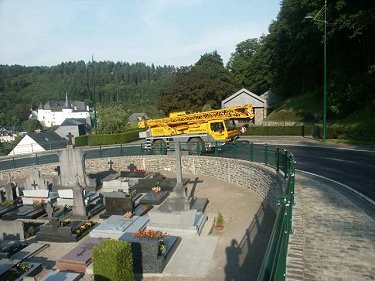
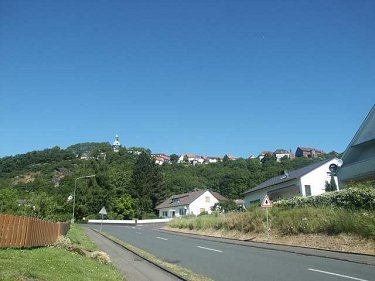
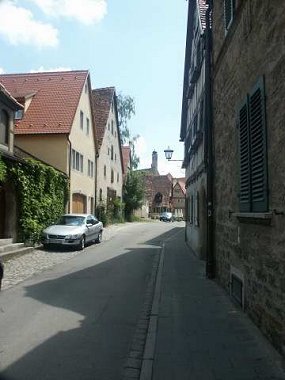
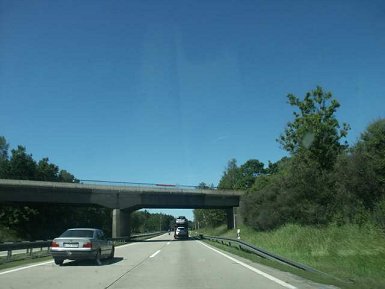
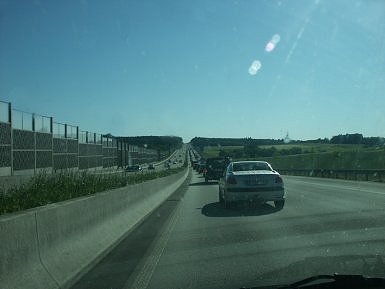
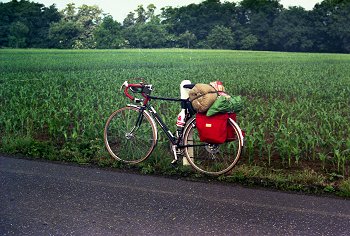
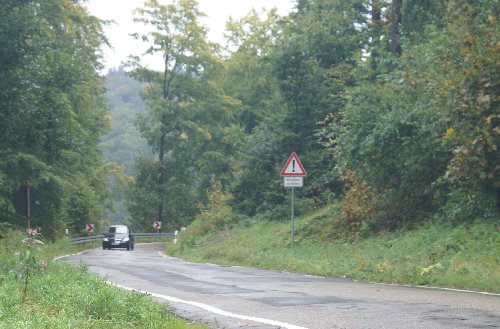
Above, in Eastern Germany, the overpasses along the Autobahn have nets under them to catch debris falling from the crumbling structures.
Below, negotiating a mountain road in the Black Forest... almost frightening!
Above, pretty typical driving in central Germany. Below, while not in Germany (this was in Clerf Belgium), the narrow roads can present a challenge when faced with big trucks.
Above, cycling is one way to tour Germany and the rest of Europe for that matter. After all, the narrow streets and difficulties with parking (below) make cycling an attractive alternative.
Above, a truck from Poland takes a dive into the ditch, while a busload of Romanian tourists attempts to negotiate around. Troubles on the umleitung off the B31 near Titisee-Neustadt, Sep 2010.

Two nasty staus- Above, a stau on the way to Giessen in 2005. Below, arguably the worst stau I've ever seen, this on the A5 traveling north towards Karlsruhe in Oct 2010. In the latter, I finally managed to get off and travel west to join the French A35 to travel north into the Pfalz.
